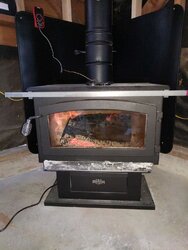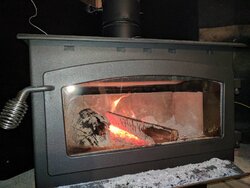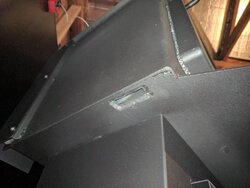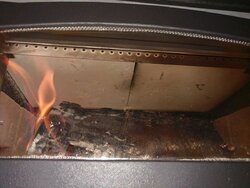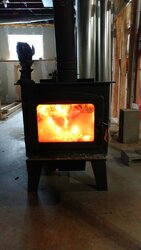Hi again Graelb. I was hoping some of the more experienced users would jump in and try to help here, but here's my take on things. It sounds like you have a good flue/chimney system, and that you've got more than adequate length to give your flue system a good draw. As far as a general start up procedure would go (forget about the flue damper for now), I was taught that you should put in enough wood to sustain a good burn. Perhaps just adding that 1 split of madrone isn't enough to keep things going for a very long time. I'd recommend that you try loading 3 splits on the bottom layer, and then a 2nd layer with another 2 splits, and pack them together nice and snug. That would give you a nice base for a long burn. So after the wood takes off, the wood is nicely charred and the fire is very lively and really starting to fill the box, you would damp down the primary air intake say around 25% closed. That will usually slow down the fire so that the flames are slow and lazy, but not going out or smoldering; if that happens you need to quickly open the primary air up a little. So once you turn it down this first time to 25% closed you leave it and watch while it slowly starts to build back up, maybe for 5 or 10 minutes. After the fire has built back up again, and it is vigorous and lively, and the temps are climbing (I monitor my flue temps and use that as my guide) then you would go and turn down the primary air again to say ~50% closed; again, the flames should get slow and lazy, and you can sit back and watch it until it builds back up again (maybe watching the flue temps and when you see them starting to climb fast) then you go over and turn it down another 25% so that your primary air inlet is now closed ~75%.... So here you go and sit back down again and wait for the fire to build back up, BUT, this is probably your last (or close to last) adjustment, and when the fire is building back up again (and the flue temps are starting to climb again) you head over and adjust it, but probably not all the way closed; this last adjustment is where you're hoping to make some very small slight adjustments to slow the blaze down slightly, but not so much that it's going to go out. I used to figure closing it to around 90% or so, so the flames are slow and lazy, the secondary's are lighting off and putting on a nice show, and your keeping your flue temps down a bit, although not too low... I wouldn't worry so much about keeping the stove top down below 600 F.... You can probably run the stove pretty safely with the stove top touching up to between 700 and 750 F at the start of your fire (and your flue temp will be slightly less than that, so maybe around 600 or 650 F). Once the fire has been burning for an hour or so they will begin to slowly drop again.... But my main point is that you don't have to be a slave to the numbers... you really have to learn how your stove burns and then try to work within it's habits... And here's where it's nice to have the Flue Damper; if you find that you've got the primary air inlet almost completely shut down, but the fire is still growing hotter and hotter (and probably the flue temps are going up as well) then you can start turning down the damper incrementally, just like you were doing with the primary air: shut it down a bit until the flames get slow and lazy, and then just watch to see if they start building back up.... if they do, damp it down a bit more, and keep watching it. Eventually you're going to hit the sweet spot where you've found that the fire is staying at a nice comfortable rate that you can live with... This is how I would approach your learning curve with your stove. I wouldn't just keep using 1 or 2 sticks, because it just ain't gonna be sustainable... you've got to feed the stove the way it was meant to be fed. Now that doesn't necessarily mean stuffing it to the gills, but 4 or 5 splits is kind of where the stove would need to start to live to its fullest potential, to attain its ultimate function as a hot blooded heating machine! It will be happy, and you will be happy. I think this would be a nice safe way for you to approach your next stage of experimentation with the stove of yours... even though I understand the difficulty of running a stove without the proper mechanisms needed to adjust the air inlet and whatnot....
Good luck brother!.


